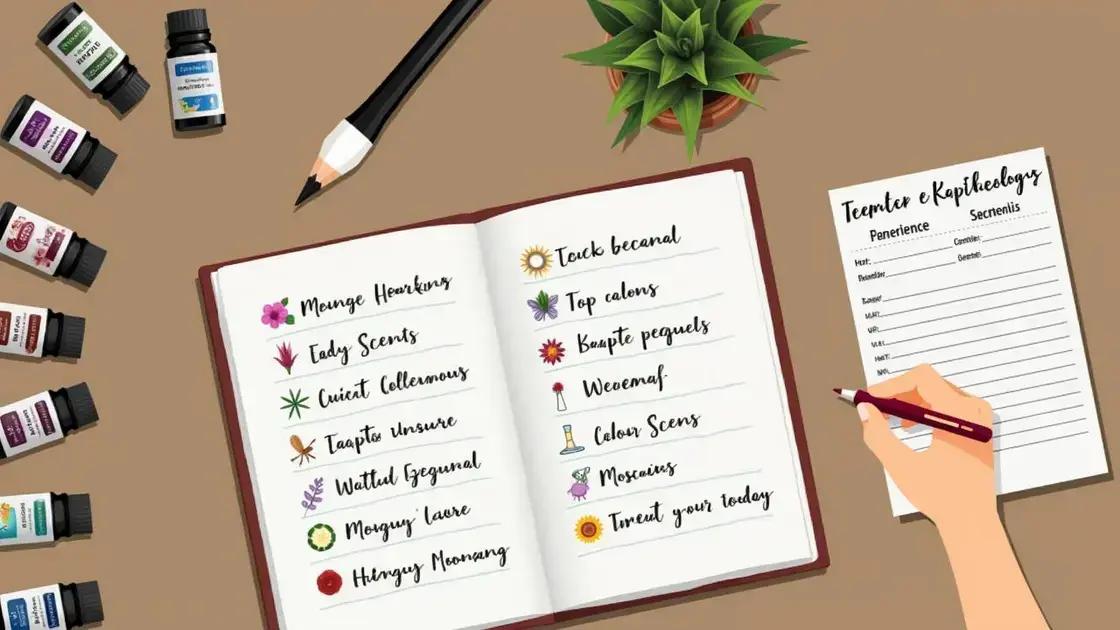The Smell Trick involves using specific scents to influence emotions and behaviors, supported by scientific principles connecting smell to the brain’s limbic system. Practical applications include enhancing productivity, managing stress, and improving memory recall. To validate effectiveness, individuals should keep journals, create controlled testing environments, and monitor mood changes. Each person’s response to scents may vary, making personal experimentation key to finding the best scent strategies.
Are you curious about how the Smell Trick can impact your life? From enhancing moods to influencing memories, the effectiveness of smell techniques can be fascinating. Many individuals are observing positive changes, but how can you truly validate these effects? In this article, we will uncover the science behind the Smell Trick, explore its practical applications, and provide tips for validating your outcomes. Whether you are using this technique for aromatherapy, stress relief, or personal well-being, understanding its validity can enhance your experience.
Understanding the Smell Trick

The Smell Trick refers to using specific scents to influence emotions and behaviors. This concept is based on the brain’s strong connection to smell, which can evoke vivid memories and feelings. When you encounter a particular scent, it can transport you to a time or place, making it a powerful tool for personal and psychological development.
Why Smell Matters
Our sense of smell is closely linked to the limbic system, the part of the brain that deals with emotions and memory. This is why certain scents can trigger strong emotional responses, such as joy, nostalgia, or relaxation. Understanding this connection is crucial when exploring the Smell Trick.
Types of Scents Used
Different scents have different effects. For example, lavender is known for its calming properties, making it ideal for reducing stress. Citrus scents like lemon and orange are often used to boost energy and mood. By becoming familiar with these various scents, you can select the right ones for your needs.
Applying the Smell Trick
To effectively use the Smell Trick, first identify what you want to achieve. Do you need relaxation, focus, or energy? Once identified, select the appropriate scent. You can use essential oils, candles, or even cooking spices to incorporate these smells into your environment.
When applying the Smell Trick, take note of your feelings, thoughts, and the context in which you use the scents. Documenting your experiences will help you understand its effectiveness better and refine your approach.
Scientific Basis Behind Smell Techniques

The scientific basis behind smell techniques lies in our neurobiology. The olfactory system, responsible for our sense of smell, directly connects to the brain’s limbic system. This part of the brain controls emotions and memories, explaining why smells can trigger intense feelings and recollections.
How Smell Works
When you inhale, odor molecules enter your nasal cavity and bind to olfactory receptors. These receptors send signals to the olfactory bulb in the brain, which then processes the information. This process is remarkably fast, often producing immediate emotional reactions based on the scent.
Research Findings
Numerous studies have confirmed the emotional power of scents. For instance, experiments show that aromas like vanilla can reduce stress and promote relaxation, while peppermint can enhance alertness and cognitive performance. Understanding these connections can help individuals effectively choose scents to suit their needs.
The Role of Memory
Scents are also potent memory triggers. Research indicates that we recall memories associated with specific smells more vividly than those connected to other senses. This phenomenon can be harnessed in practical applications, such as using familiar scents during study sessions to improve recall during exams.
Additionally, scent perception can vary from person to person due to genetics and personal experiences. This variation shows that what works for one individual may differ for another, highlighting the importance of personal exploration in finding effective smell techniques.
Practical Applications of Smell Tricks

There are many practical applications of smell tricks that can enhance daily life. From boosting productivity to creating calming environments, understanding how to use scents effectively can bring numerous benefits.
In the Workplace
One of the most effective ways to apply smell tricks is in the workplace. Citrus scents, like lemon or orange, can help to increase focus and energy levels. Using a diffuser with these smells during work hours can improve mood and productivity. Additionally, scents like peppermint have been shown to enhance mental clarity, making them ideal for brainstorming sessions or intense work periods.
In Stress Relief
For stress relief, aromas such as lavender and chamomile are excellent options. They help to reduce anxiety and promote relaxation. Creating a calming space with these scents can be beneficial after a long day. You can use candles, essential oil diffusers, or even potpourri to infuse the ambiance with soothing fragrances.
Enhancing Memories
Using scents to enhance memories can also be a powerful application. For example, students can study with particular scents, and then use the same scent during exams. This can help trigger recall and improve performance. Similarly, incorporating a loved one’s favorite scent at special events can create lasting memories.
In Aromatherapy
Aromatherapy is another practical application of smell tricks. Many people use essential oils to address various health issues. Eucalyptus, for instance, can help with respiratory issues, while tea tree oil is known for its antibacterial properties. Proper application through inhalation or topical use can enhance well-being and contribute to a healthier lifestyle.
Tips to Validate Your Smell Trick Outcomes

To effectively validate your smell trick outcomes, a systematic approach is essential. Here are some helpful tips to get you started in measuring the impact of scents on your well-being.
1. Keep a Journal
Document your experiences with different scents. Write down what scents you use, the duration of exposure, and how you feel before and after. This record will help identify patterns and effectiveness over time.
2. Use Controlled Environments
Create controlled environments for testing. Use the same scent in similar settings and situations to assess its impact consistently. This can help minimize external factors that might influence your feelings and outcomes.
3. Set Specific Goals
Define clear goals for what you want to achieve with each smell trick. Are you aiming for relaxation, focus, or mood enhancement? Having specific objectives makes it easier to evaluate whether a given scent meets your expectations.
4. Include a Variety of Scents
Experiment with a variety of scents to see which ones are most effective for you. Pay attention to personal preferences, as different people may respond differently to various aromas. This way, you can find personalized options for your smell tricks.
5. Solicit Feedback
If trying scents within a group, solicit feedback from others regarding their experiences. This can provide valuable insights and perspectives that you may not have considered, helping you validate the effectiveness of your smell tricks.
6. Monitor Your Mood
Before and after using a scent, take note of your mood or physical state. Use a scale from 1 to 10 to rate your feelings. This quantitative data will help you draw conclusions about the scents’ effectiveness over time.
In Summary: Unlocking the Power of Smell Tricks
The Smell Trick offers a fascinating way to enhance well-being and improve various aspects of life, from boosting productivity in the workplace to creating calming environments for relaxation.
Understanding the scientific basis behind these techniques is essential for their effective application. With practical tips for validation, anyone can tailor their experiences to achieve desired emotional and cognitive outcomes.
By keeping a journal, creating controlled testing environments, and monitoring your feelings, you can truly gauge the effectiveness of your smell strategies. Remember, the journey of exploring scents is personal, so be open to experimentation and feedback.
Ultimately, leveraging smell tricks can profoundly impact your daily experiences, helping you to create an atmosphere that best serves your needs.
FAQ – Frequently Asked Questions About Smell Tricks
What is a smell trick?
A smell trick involves using specific scents to influence emotions and behaviors, enhancing experiences like relaxation or focus.
How do I choose the right scent for my needs?
Identify your goals first. For relaxation, consider lavender; for focus, try citrus scents like lemon or orange.
What scientific basis supports the use of smell techniques?
The connection between smell and emotion is rooted in our neurobiology, where scent triggers emotional responses in the limbic system.
How can I validate the effectiveness of my smell tricks?
Keep a journal to document your experiences, use controlled environments for testing, and monitor your mood before and after using scents.
Are there specific settings where smell tricks are most effective?
Yes, smell tricks can be especially effective in workplaces for productivity, at home for relaxation, and during study sessions for memory enhancement.
Can smell tricks affect everyone the same way?
No, responses to scents vary from person to person due to individual preferences, experiences, and genetic factors.












